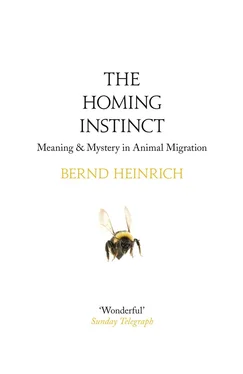In this book I cannot hope to provide an in-depth treatment of any issue. My viewpoint is wide, and admittedly personal. Thousands of scientific references are possible for any one topic, and I am not an expert on any topic. Those references I cite are in no way meant to be the specific last word on the topic. They tend to be those I am most familiar with. I apologize for all of the amazing stories and all the details that I have left out. I have tried to speculate freely, and I hope that this will open discussion, not close it.
 PART I
PART I
A skull I have lying on my desk is as big around as a somewhat flattened coffee mug, but it comes to a point at the front and has two large eye sockets. The bone on the top of the head is sculpted in ridges and furrows and looks like weathered stone. Seen from the back, the skull has a backward-opening hole on each side. The holes anchored the animal’s powerful jaw muscles. Between them is a much smaller hole. I am looking through this hole (foramen magnum) for the brain cavity, but this large head contains scarcely any brain at all, just an extension of the dorsal nerve cord that runs up from the neck.
It’s the skull of a snapping turtle, a female who met her end as she was crossing the road to dig a hole in the gravel to lay her clutch of eggs. As in previous years, she had come from her bog a mere hundred meters away.
The local snapping turtle is no great wanderer. But two sea turtles — the green turtle, Chelonia mydas, and the leatherback, Dermochelys coriacea — are renowned for migrations spanning entire oceans. The leatherback as an adult feeds in northern cold waters but nests on tropical beaches. It can weigh up to a ton, and although the skull of one that I had the opportunity to examine was as big as a basketball, the cavity holding its brain was, like the snapping turtle’s, only a slight expansion at the end of the vertebral column. It could barely have held a walnut. The green’s could have held two hazelnuts. Their skulls hardly differ from that of any turtle, whether of a species alive now or one that lived 215 million years ago, at a time at least three times more distant than that of the last dinosaurs.
The minute dimensions of some animals’ brains are as astounding as the homing capacity of some of their owners. Like albatrosses, sea turtles of various species lay their eggs in colonies with others of their kind on specific ocean beaches. After the young hatch from the eggs buried in the sand, they head for the water and spend years at sea. They may travel thousands of kilometers, and then, a decade or two later when they are ready to lay their eggs, they return to their birthplace. They mate in the water nearby, and the females then come ashore to dig their nest holes in the sand and to drop in their eggs. How are they able to find their old home after years of wandering in the vastness of the oceans, when we, if taken blindfolded to and then released in unfamiliar woods, would, despite our highly sophisticated massive brains, be as likely to head off in a wrong as a right direction? To get around in unknown territory most of us need a map with which to find at least one known fixed feature that we can both see on the ground and locate on that map, and a compass.
What knowledge and what kind of urges does it take for some birds to fly nonstop for nearly ten thousand kilometers, spending all day and night on the wing, until their body weight halves as they not only burn up all of their body’s food stores but even sacrifice muscle, digestive tract, and other entrails — almost everything except their brains?
If feeling fails you, vain will be your course.
— Johann Wolfgang von Goethe, Faust
MILLIE AND ROY ARE A PAIR OF SANDHILL CRANES THAT STAY for most of the year in Texas or Mexico but travel north in April and have for at least fifteen years nested and raised their one or two offspring, known as colts, in a small bog in the Goldstream Valley near Fairbanks, Alaska. Their home is adjacent to the home of my friends George Happ and his wife, Christy Yuncker. George was an insect physiologist and chairman of the Zoology Department at the University of Vermont where I was hired in 1980, and he later moved to the University of Alaska and the land of the Iditarod, where the two built their home in the wild land near Fairbanks. They invited me to visit them and “their” cranes, and I was eager to do it.
The thousands of square kilometers of central Alaska’s permafrost-covered taiga consist of stunted blue-green spruce and white birch, with a groundcover of green-yellow moss and twiggy Labrador tea whose evergreen leaves curl at the edges and have a soft beige fuzz on their undersides. Chalky lichen and small shiny cranberry leaves decorate a thin black soil overlying the permafrost that can extend thirty meters down. In this expanse, there are many bogs or pingos, which are the result of an ice dome (groundwater that freezes into an upwardly bulging ice lens) that has melted and created a depression where a pond or a lake is then formed. After a few centuries, a floating mat of vegetation grows in from the edges to create a floating bog. Such pingo bogs have become the favorite home sites of sandhill cranes.
Portrait of Millie and Roy
George and Christy’s pingo in the Goldstream Valley is, like others, clear of trees but surrounded by stunted black spruces. It is the home site not only for the crane pair but also for Bonaparte’s and mew gulls, pintail and mallard ducks, and sometimes horned grebes. I intended to arrive several days in advance of the cranes’ anticipated return, to try to watch their homecoming. Surely this return during the first week in May would be a big event in their lives, and I wanted to see their reactions to their old home.
Millie and Roy had last been seen as they left the bog in the previous year, on September 11, 2008, for their southward migration. They had been delayed from their normal end-of-August departure date because Oblio, their colt, had a leg injury that prevented him from being ready in time for the family flight to western Texas. Waiting for him saved his life; we know that young cranes, as well as geese and swans, learn the route between wintering and breeding homes from their parents. The proof and the implications of the necessity of the young to be able to follow their parents, or alloparents, in order to migrate were perhaps most convincingly demonstrated by William Lishman after he first played parent to hand-raised geese that he later led as a flock with an ultralight aircraft. He also led sandhills in this way. Finally he led a flock of whooping cranes from their breeding grounds in Wisconsin to establish new homes for them in Florida. However, nobody as far as I know has been able to follow wild birds, and my chances of seeing Millie and Roy touch down for the first time on their arrival this year might be slim. But I felt it was worth a try.
Cranes, like other large birds, grow slowly. It takes them thirty to thirty-two days to incubate their two eggs, and another fifty-five days for their (usually one) colt to be able to fly well enough to migrate. This far north there is only a narrow window of time for cranes to breed successfully, especially for those that fly even farther to breed, as some of those wintering in Mexico do, in Siberia. If late in arriving, they waste their effort of migrating the thousands of kilometers north. If they are too early, snow and ice cover all food sources. This year had been a winter of heavy snows in central Alaska. Even the boreal owls were starving from their inability to reach the voles under the snow. By late April, when I arrived, the woods around Millie and Roy’s home bog were still under at least half a meter of snow, and the cranes had not yet shown up.
Читать дальше

 PART I
PART I










